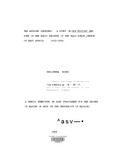The Akurinu churches: a study of the history and some of the basic beliefs of the Holy Ghost Church of East Africa 1926-1980
Abstract
This study is an investigation of the history, beliefs
and practices of /Holy Ghost Church of East Africa; a spirit/the
type church that belongs to the movement popularly known
among the Kikuyu of Central Kenya as, Akurinu. The
period chosen is 1926-1980. Among other factors, this
study was instigated by the observation that African
Christianity and particularly Kenyan Christianity, is
characterised by a multiplicity of denominations. These new
denominations or sects are today referred to as African
Independent Churches.
In the last few decades there have been surveys of
some areas or of groups of such .Churches as indicated In the
Literature Review. These studies have provided outlines of
the history, beliefs and practices of some of these Independent
Church movements. Some of the studies have also addressed
themselves to the question of the causes which have led to
the emergence of these churches. However, little attention
has been paid to the theological factor as a cause of
Church Independency. This study therefore, attempts to
highlight among other factors, the theological factor in
the emergence of the Akurinu movement.
From the study of all the available information from
the field and from both primary and secondary sources on
the Akurinu Movement and particularly the Holy Ghost Church
of East Africa, three important facts have been established.
Firstly, that the Akurinu Churches have been in
existence since 1926 and the causes of their emergence are
many and varied. Secondly, that their beliefs and practices
were developed from both the Bible and the Kikuyu religious
heritage and they have undergone changes since 1926. Thirdly,
that disagreement on theological issues is an important
causative factor of African Church Independency.
In order to establish the ahove facts, the study begins
in Chapter One with an examination of the existing views on
the rise of Independent Churches. Most of the material in
this chapter is collected from written sources. Chapter Two
outlines the Kikuyu traditional background, its religion,
socia] organisation and the effects colonialism and western
culture had on this society . This chapter concludes that
the Akurinu Churches are to a certain extent products of the
conflicts and tensions created by the economic, political,
social, -religious and Cultural pressures of the period
1830-1930.
Chapter Three discusses the origin, history and
development of the Akurinu Chur,ches and their organisational
structure, and also gives a brief history of the chief
founder of the Church between 1926-1934.
Chapters Four, Five, Six and Seven discuss the major
distinctive beliefs of the Holy 6host Church of East Africa,
namely, the Holy Spirit, the concept of prophecy, spirit
,baptism and the concept of ritual uncleanness or Thahu.
'These beliefs .are significant because the Akurinu churches
differ from other churches in the way they hold and
understand these particular beliefs. It was also on account
of their understanding and experience of the Holy Spirit
that some of the founder members were expelled from the
African Inland Church, Kijabe in 1927.
Chapter Eight is the conclusion and sums up the main
findings of the study. This study is not exhaustive and
it is pointed out,that there is still much that requires
to be researched especially on the other beliefs and practices
of the Akurinu churches, such as marriage, ordination,
funeral rites, and community life. Their theology can also
be studied from an analysis of the beliefs and practices as
well as their hymn book, Nyimbo cia Roho Mutheru.
Citation
Masters of Arts DegreePublisher
University of Nairobi Department of Arts
Description
A thesis submitted in part fulfillment for the Degree
of Master of Arts in the University of Nairobi

